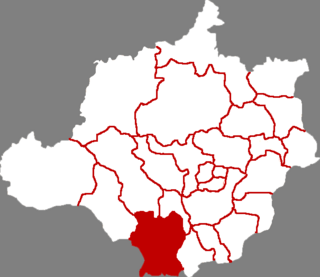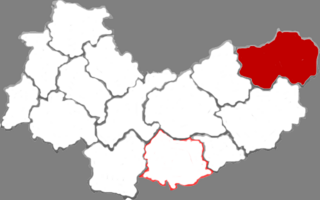The history of the administrative divisions of the Imperial China is quite complex. Across history, what is called 'China' has taken many shapes, and many political organizations. For various reasons, both the borders and names of political divisions have changed—sometimes to follow topography, sometimes to weaken former states by dividing them, and sometimes to realize a philosophical or historical ideal. For recent times, the number of recorded tiny changes is quite large; by contrast, the lack of clear, trustworthy data for ancient times forces historians and geographers to draw approximate borders for respective divisions. But thanks to imperial records and geographic descriptions, political divisions may often be redrawn with some precision. Natural changes, such as changes in a river's course, or loss of data, still make this issue difficult for ancient times.

Shou County or Shouxian is a county in the north-central part of Anhui Province, China, and is located on the southern (right) bank of the Huai River. It is the southernmost county-level division of the prefecture-level city of Huainan. Its population is 1,280,000 and its area is 2,986 km2 (1,153 sq mi). It is a National Cultural and Historical City. the jurisdiction of Shou County was transfer from Lu'an to Huainan.

Dingzhou, or Tingchow in Postal Map Romanization, and formerly called Ding County or Dingxian, is a county-level city in the prefecture-level city of Baoding, Hebei Province. As of 2009, Dingzhou had a population of 1.2 million. Dingzhou has 3 subdistricts, 13 towns, 8 townships, and 1 ethnic township. Dingzhou is about halfway between Baoding and Shijiazhuang, 196 kilometers (122 mi) southwest of Beijing, and 68 kilometers (42 mi) northeast of Shijiazhuang.

Li Mu was a general of the Zhao state during the Warring States period of Chinese history. He was named by Chinese historians as one of the four greatest generals of the Warring States period, along with Bai Qi, Wang Jian and Lian Po.

Dai County, also known by its Chinese name Daixian, is a county in Xinzhou, Shanxi Province, China. Its county seat at Shangguan is also known as Daixian. The county has an area of 1,729 km2 (668 sq mi) and had a population of 214,091 at the time of the 2010 census. The county is the home of the AAAAA-rated Yanmen Pass Scenic Area along the Great Wall, as well as the Bianjing Drum Tower, the Ayuwang Pagoda, and the Zhao Gao Forest Park.

Fanshi County, is a county in Xinzhou City, in the northeast of Shanxi Province, China, bordering Hebei province to the southeast. It is the easternmost county-level division of Xinzhou.

Yu County, also known by its Chinese name Yuxian, is a county under the jurisdiction of the prefecture-level city of Zhangjiakou in northwestern Hebei province, China. Yuzhou (蔚州镇) is the county seat.

Loufan County is a county under the jurisdiction of Taiyuan, the capital of Shanxi Province in the People's Republic of China. It is the westernmost county-level division of Taiyuan.

Hunyuan County is a county under the administration of Datong City, in the northeast of Shanxi province, China.
Shuocheng District, formerly Shuo County, is the main urban district of the prefecture-level city of Shuozhou in Shanxi province, China.

Youyu County, also known by its Chinese name Youyuxian, is a county under the administration of the prefecture-level city of Shuozhou, in the northwest of Shanxi Province, China. It borders Inner Mongolia to the north and west.

Yanmen Pass, also known by its Chinese name Yanmenguan and as Xixingguan, is a mountain pass which includes three fortified gatehouses along the Great Wall of China. The area was a strategic choke point in ancient and medieval China, controlling access between the valleys of central Shanxi and the Eurasian Steppe. This made it the scene of various important battles, extending into World War II, and the area around the gatehouses and this stretch of the Great Wall is now a AAAAA-rated tourist attraction. The scenic area is located just outside Yanmenguan Village in Yanmenguan Township in Dai County, Xinzhou City, Shanxi Province, China.
Jiaozhou was an imperial Chinese province under the Han and Jin dynasties. Under the Han, the area included Liangguang and northern Vietnam but Guangdong was later separated to form the province of Guangzhou by Sun Quan following the death of Shi Xie.

Dai Prefecture, also known by its Chinese name Daizhou, was a prefecture (zhou) of imperial China in what is now northern Shanxi. It existed intermittently from AD 585 to 1912. Its eponymous seat Daizhou was located at Shangguan in Dai County. The territory it administered included all or part of what are now the counties of Dai, Wutai, Fanshi, and Yuanping in Shanxi's Xinzhou Prefecture.
Jin Prefecture, also known by its Chinese name Jinzhou, was a prefecture of imperial China. Its seat—also known as Jinzhou—was at Luyang.

Dai Commandery was a commandery (jùn) of the state of Zhao established c. 300 BC and of northern imperial Chinese dynasties until the time of the Wen Emperor of the Sui dynasty. It occupied lands in what is now Hebei, Shanxi, and Inner Mongolia. Its seat was usually at Dai or Daixian, although it was moved to Gaoliu during the Eastern Han.
Lake Huangqi, also known by its Chinese name as the Huangqi Hai, is a lake in Chahar Right Front Banner, Ulanqab Prefecture, Inner Mongolia, China.
Gaocun Town is a town and the county seat of Mayang Miao Autonomous County in Hunan, China. The town is located in the mid-northern region of the county, it was reformed to merge Luxikou Township, Liping Township, Gudapo Township and the former Gaocun Town on November 25, 2015, it has an area of 187.6 km2 (72.4 sq mi) with a population of 104,300. The town was divided into 37 villages and communities in May 2016, the seat of local government is at Gaocun.(Chinese: 高村).













